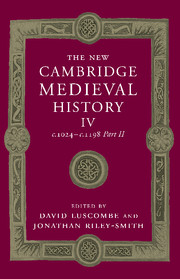Book contents
- Frontmatter
- 1 Introduction
- 2 The papacy, 1024–1122
- 3 The western empire under the Salians
- 4 Italy in the eleventh century
- 5 The kingdom of the Franks to 1108
- 6 Spain in the eleventh century
- 7 England and Normandy 1042–1137
- 8 The Byzantine Empire, 1025–1118
- 9 Kievan Rus’, the Bulgars and the southern Slavs, c. 1020 – c. 1200
- 10 Poland in the eleventh and twelfth centuries
- 11 Scandinavia in the Eleventh and Twelfth Centuries
- 12 Hungary in the Eleventh and Twelfth Centuries
- 13 The papacy, 1122–1198
- 14 The western empire, 1125–1197
- 15 Italy in the twelfth century
- 16 Spain in the twelfth century
- 17 The kingdom of the Franks from Louis VI to Philip II
- 18 England and the Angevin dominions, 1137–1204
- 19 Scotland, Wales and Ireland in the Twelfth Century
- 20 The Byzantine Empire, 1118–1204
- 21 The Latin East, 1098–1205
- 22 ’Abbasids, Fatimids and Seljuqs
- 23 Zengids, Ayyubids and Seljuqs
- Appendix: genealogical tables
- List of primary sources
- Bibliography of Secondary Works Arranged by Chapter
- Index
- Map 1a The western empire: Burgundy and Provence in the eleventh century"
- Map 1b The western empire: Germany and the north-eastern frontier of Christendom in the eleventh century"
- Map 3 The kingdom of the Franks"
- Map 4 England and Normandy"
- Map 10 Germany under Frederick Barbarossa, c. 1190">
- Map 12 The Angevin empire"
- References
19 - Scotland, Wales and Ireland in the Twelfth Century
Published online by Cambridge University Press: 28 March 2008
- Frontmatter
- 1 Introduction
- 2 The papacy, 1024–1122
- 3 The western empire under the Salians
- 4 Italy in the eleventh century
- 5 The kingdom of the Franks to 1108
- 6 Spain in the eleventh century
- 7 England and Normandy 1042–1137
- 8 The Byzantine Empire, 1025–1118
- 9 Kievan Rus’, the Bulgars and the southern Slavs, c. 1020 – c. 1200
- 10 Poland in the eleventh and twelfth centuries
- 11 Scandinavia in the Eleventh and Twelfth Centuries
- 12 Hungary in the Eleventh and Twelfth Centuries
- 13 The papacy, 1122–1198
- 14 The western empire, 1125–1197
- 15 Italy in the twelfth century
- 16 Spain in the twelfth century
- 17 The kingdom of the Franks from Louis VI to Philip II
- 18 England and the Angevin dominions, 1137–1204
- 19 Scotland, Wales and Ireland in the Twelfth Century
- 20 The Byzantine Empire, 1118–1204
- 21 The Latin East, 1098–1205
- 22 ’Abbasids, Fatimids and Seljuqs
- 23 Zengids, Ayyubids and Seljuqs
- Appendix: genealogical tables
- List of primary sources
- Bibliography of Secondary Works Arranged by Chapter
- Index
- Map 1a The western empire: Burgundy and Provence in the eleventh century"
- Map 1b The western empire: Germany and the north-eastern frontier of Christendom in the eleventh century"
- Map 3 The kingdom of the Franks"
- Map 4 England and Normandy"
- Map 10 Germany under Frederick Barbarossa, c. 1190">
- Map 12 The Angevin empire"
- References
Summary
for all three of the countries whose development is reviewed in this chapter, a leading theme was provided by the continuing after-effects of the Norman Conquest of England, which made themselves felt far into the twelfth century and beyond. The Norman conquerors and colonizers who flocked to England in the forty years separating the battles of Hastings and Tinchebray hardly raised their sights sufficiently to take in southern Scotland and showed almost no interest in Ireland. There was already in 1066 a lengthy history of close relations, friendly and unfriendly, between Wessex and Mercia on the one hand and the Welsh kingdoms or principalities on the other. Even if the Norman kings had been willing to stand aloof from the situation in Wales the aggressive and acquisitive conduct of some of their closest followers would have compelled them to intervene if only to prevent the creation of dangerously independent lordships on their western frontier. The expansion policy pursued successfully before 1100 in the north and mid-Wales, and only to a slightly lesser extent in the south, meant that not only the incoming conquerors but also the Welsh princes were brought ineluctably within the political segment of north-west Europe which it is convenient to think of as Anglo-Norman. Moreover, by seizing the English kingship Duke William automatically became heir to a tradition, reaching back at least to the tenth century, of English claims to exercise some kind of lordship over the kings of Scots. Ireland was a different matter, yet although the Conqueror in 1081 stopped short at St David’s and demanded no tribute from Irish kings or trading towns the fact that both Lanfranc and Anselm, as archbishops of Canterbury, laid claim to an ecclesiastical hegemony over the Irish bishops, together with the occasional freelance venture into Irish affairs by Norman settlers in Wales such as Arnulf of Montgomery, lord of Pembroke, kept Ireland in focus as it were, to remain until the 1170s the greatest single imponderable in English royal policy.
- Type
- Chapter
- Information
- The New Cambridge Medieval History , pp. 581 - 610Publisher: Cambridge University PressPrint publication year: 2004
References
- 2
- Cited by

